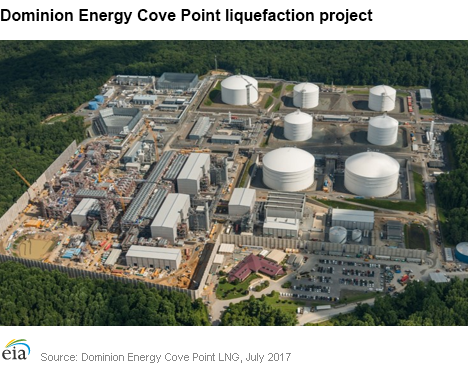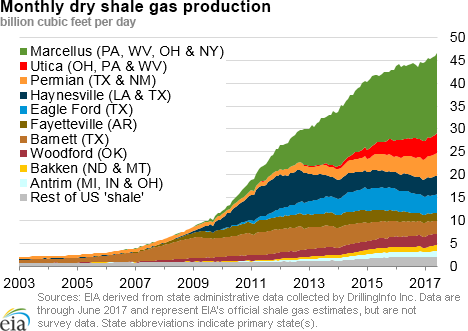Updated September 7, 2017 to conform to data from PointLogic.
In the News:
Exports of domestically sourced LNG from the East Coast expected in 4Q 2017
Dominion Energy has announced that the 750 million cubic feet per day (MMcf/d) Cove Point Liquefaction Project is in its final stages of construction, confirming with EIA that it is 95% complete as of August 2 and expected to be in-service in the fourth quarter of 2017. Located on the Chesapeake Bay in Lusby, Maryland, it will be the second large-scale liquefaction export facility to begin operations in the Lower 48 states and the first on the East Coast.
In addition to construction of the liquefaction terminal, which began in October 2014, this project includes the installation of additional compression at Dominion’s Pleasant Valley compressor station in Fairfax County, Virginia, as well as upgrades to the Cove Point pipeline in Loudon County, Virginia. These projects were necessary to allow for sufficient injection of feedstock natural gas from the Marcellus and Utica shale gas plays, which can be supplied by either the Transcontinental pipeline, the Columbia Gas pipeline, or the Dominion Transmission pipeline.
Cove Point is expected to serve as both a liquefied natural gas (LNG) import and export facility. Most activity at the terminal will likely be exporting LNG. While Cove Point has the capacity to send out 1.8 billion cubic feet per day (Bcf/d) of natural gas (about 650 Bcf annually) into the domestic pipeline grid, it only received three cargoes this past winter, totaling 9.3 Bcf. In contrast, the LNG export capacity (0.75 Bcf/d nameplate, or an operational capacity of 0.66 Bcf/d after expected maintenance downtime) is fully contracted for 20 years by two companies: Pacific Summit Energy (PSE) LLC, an energy marketing and trading company and a subsidiary of the Sumitomo Corporation in Japan, and GAIL Global (USA) LNG LLC, a subsidiary of GAIL (India) Ltd. Both PSE and GAIL have contracted for about equal shares of the facility’s export capacity.
Two Japanese utilities, Tokyo Gas and Kansai Electric, signed 20-year purchase agreements with PSE’s parent company, Sumitomo, to purchase 1.4 million tonnes per annum (MTPA) (0.20 Bcf/d) and 0.8 MTPA (0.11 Bcf/d), respectively. GAIL’s contract with Dominion is one of more than 30 Master Sales Purchase Agreements (MSPAs) the company has signed with international LNG suppliers. In addition to off-taking LNG for use in India’s fertilizer sector and electric power sector, the company also expects to become active in inter-regional LNG trade through its wholly-owned subsidiary company, GAIL Global Singapore Pte, Ltd.
Both PSE and GAIL entered into 20-year purchase agreements for natural gas. PSE signed a 20-year purchase agreement with Cabot Oil and Gas Corporation to purchase 0.34 Bcf/d of natural gas from the Marcellus shale play. Similarly, GAIL has signed a 20-year contract to purchase natural gas from WGL Midstream Inc.
Overview:
(For the Week Ending Wednesday, August 9, 2017)
- Natural gas spot price movements were mixed this report week (Wednesday, August 2 to Wednesday, August 9). The Henry Hub spot price rose from $2.77 per million British thermal units (MMBtu) last Wednesday to $2.85/MMBtu yesterday.
- At the New York Mercantile Exchange (Nymex), the September 2017 contract price rose 7¢ from $2.811/MMBtu last Wednesday to $2.883/MMBtu yesterday
- Net injections to working gas totaled 28 billion cubic feet (Bcf) for the week ending August 4. Working natural gas stocks are 3,038 Bcf, which is 8% less than the year-ago level and 2% more than the five-year (2012–16) average for this week.
- The natural gas plant liquids composite price at Mont Belvieu, Texas, rose by 2¢, averaging $6.79/MMBtu for the week ending August 9. The prices of ethane, butane, and isobutane fell by 1%, 2%, and 1%, respectively. The price of propane rose by 2%. The price of natural gasoline remained flat week over week.
- According to Baker Hughes, for the week ending Friday, August 4, the natural gas rig count decreased by 3 to 189. The number of oil-directed rigs fell by 1 to 765. The total rig count decreased by 4, and it now stands at 954.
Prices/Supply/Demand:
Price movements are mixed. Temperatures moderated slightly across the country this report week, averaging below seasonal norms almost everywhere outside of the Pacific Coast. This report week (Wednesday, August 2 to Wednesday, August 9), the Henry Hub spot price rose 8¢ to $2.85/MMBtu yesterday. At the Chicago Citygate, prices increased 3¢ to $2.80/MMBtu yesterday. These small price movements may be partly a reflection of weather forecasts rather than temperatures for the week.
Temperatures in California were consistently above seasonal norms, but trended cooler as the week went on. Prices at PG&E Citygate in Northern California rose 1¢, up to $3.26/MMBtu yesterday. The price at SoCal Citygate decreased 33¢ to $3.23/MMBtu yesterday, reflecting moderating temperatures in California throughout the report week.
Northeast prices fall. At the Algonquin Citygate, which serves Boston-area consumers, prices went down $1.14 from $3.22/MMBtu last Wednesday to $2.08/MMBtu yesterday. At the Transcontinental Pipeline Zone 6 trading point for New York, prices decreased 81¢ from $2.58/MMBtu last Wednesday to $1.77/MMBtu yesterday. Much of the price drop occurred between Wednesday and Thursday of last week, as temperatures began to cool off in the region.
Tennessee Zone 4 Marcellus spot prices decreased 22¢ to $1.62/MMBtu yesterday. Prices at Dominion South in northwest Pennsylvania fell 33¢ to $1.59/MMBtu yesterday. Likely reflecting regional infrastructure constraints, prices in both the Marcellus region and in New York City are once again trading well below the Henry Hub price.
September contract price decreases. At the Nymex, the price of the September 2017 contract increased 7¢ to $2.883/MMBtu yesterday. The price of the 12-month strip averaging September 2017 through August 2018 futures contracts climbed 5¢ to $2.997/MMBtu.
Supply remains flat again this week. According to data from PointLogic Energy, the average total supply of natural gas remained the same as the previous report week, averaging 79.1 billion cubic feet per day (Bcf/d). Dry natural gas production grew by 1% compared with the previous report week. Average net imports from Canada decreased by 2% from last week.
Demand falls slightly. Total U.S. consumption of natural gas fell by 1% compared with the previous report week, according to data from PointLogic Energy. Week over week, electric sector consumption of natural gas decreased by 4%, reflecting overall moderating summer weather. Industrial sector consumption increased by 1%, and residential and commercial sector consumption increased by 16%. Natural gas exports to Mexico increased 2%.
U.S. LNG exports down week over week Three vessels (combined LNG-carrying capacity of 9.9 Bcf) departed the Sabine Pass last week (Thursday to Wednesday) and one vessel (LNG-carrying capacity 3.8 Bcf) was loading at the terminal on Wednesday.
Cheniere Energy, an operator of Sabine Pass liquefaction facility, announced that first production from Train 4 was achieved in late July and that the first LNG cargo from Train 4 will be shipped this week. Sempra Energy, a developer of the Cameron LNG project in Louisiana—one of the six U.S. liquefaction facilities currently under construction—announced a delay in the expected online date, from mid-2018 to 2019. Cameron LNG is a three-train facility with a combined capacity of 1.6 Bcf/d.
Storage:
Weekly net injections are lower than the five-year average for the fifth week in a row. Net injections into storage totaled 28 Bcf, compared with the five-year (2012–16) average net injection of 54 Bcf and last year's net injections of 24 Bcf during the same week. The smaller-than-average net injections this week likely resulted from the warmer-than-normal temperatures in most of the Lower 48 states and increasing cooling demand for natural gas. This pattern was most pronounced in the South Central region, where warmer-than-normal temperatures resulted in net withdrawals from storage totaling 9 Bcf, compared with a five-year average net injection of 1 Bcf in the region. Working gas stocks total 3,038 Bcf, which is 61 Bcf more than the five-year average and 275 Bcf less than last year at this time.
Net withdrawals from storage are reported in the South Central region for the fourth week in a row. This week also marks the fourth week in a row that net withdrawals were reported for each of the subregions of the South Central region. Net withdrawals from storage in the South Central region occurred at both salt and nonsalt facilities. Withdrawals from salt facilities totaled 7 Bcf on the week and withdrawals from nonsalt facilities were 2 Bcf. Net withdrawals from storage have been reported at salt storage facilities during seven of the past eight report weeks. So far in the refill season, net injections into working storage have totaled 4 Bcf gas in the salt region, 157 Bcf in the nonsalt region, compared with last year at this time, when the salt region net withdrawals totaled 8 Bcf and the nonsalt region posted net injections of 125 Bcf.
So far in the 2017 refill season, net injections into working gas storage are lower than the five-year average in most regions of the Lower 48 states. Net injections into working gas have been at 987 Bcf since March 31, 2017—the traditional beginning of the refill season—compared with the five-year average of 1,191 Bcf over the same period. Smaller-than-average net injections to date during the 2017 injection season are the result of relatively high electric sector demand (which was coupled with warmer-than-normal temperatures on average), high levels of natural gas exports, and storage levels that were already above average at the start of the refill season. The East region is the only region where net injections have exceeded the five-year average. Cumulative net injections during the 2016 refill season in the Lower 48 states totaled 835 Bcf by this time, which were also characterized by unusually high storage levels at the start of the 2016 refill season.
The January 2018 futures price continues trading at a premium over the current spot price. During the most recent storage week, the average natural gas spot price at the Henry Hub was $2.81/MMBtu, while the Nymex futures price of natural gas for delivery in January 2018 averaged $3.21/MMBtu, a difference of 40¢. The premium was 53¢ a year ago. The average natural gas spot price at the Henry Hub was 2¢ lower than the front-month futures price at the Nymex. A year ago, the spot price was 3¢ higher than the front-month contract.
Reported net implied flows into storage fall below the range of analysts’ expectations. According to The Desk survey of natural gas analysts, estimates of net injections to working natural gas storage ranged from 32 Bcf to 44 Bcf with a median of 36 Bcf. Prices on the futures contract for September delivery increased 4¢/MMBtu to $2.93/MMBtu with 2,578 contracts traded at the release of the WNGSR. Prices for the September contract climbed to $2.94/MMBtu in subsequent trading.
Temperatures were close to normal on average in the Lower 48 states during the storage week, but considerably wamer than normal west of the Rockies. Temperatures in the Lower 48 states averaged 75 degrees Fahrenheit (°F), the same as the normal and 3°F lower than last year at this time. However, on a regional basis, temperatures were somewhat more varied. Most regions east of the Rockies reported lower-than-normal temperatures, ranging from 70°F to 77 °F, or up to 3°F lower than normal. West of the Rockies temperatures were warmer than normal. Temperatures in the Pacific Census division averaged 77°F, 6°F higher than the normal and the same as last year at this time.
See also:
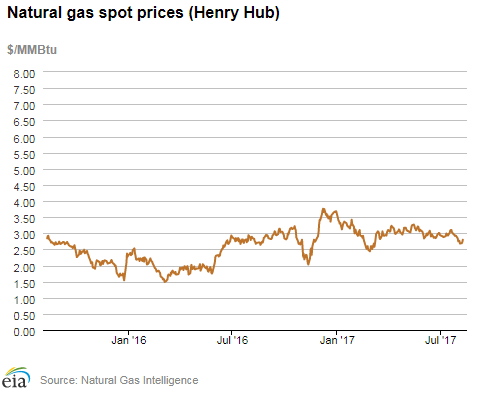
| Spot Prices ($/MMBtu) | Thu, 03-Aug |
Fri, 04-Aug |
Mon, 07-Aug |
Tue, 08-Aug |
Wed, 09-Aug |
|---|---|---|---|---|---|
| Henry Hub |
2.78 |
2.76 |
2.75 |
2.77 |
2.85 |
| New York |
1.87 |
1.73 |
1.90 |
1.89 |
1.77 |
| Chicago |
2.76 |
2.68 |
2.69 |
2.72 |
2.80 |
| Cal. Comp. Avg.* |
2.92 |
2.81 |
2.78 |
2.80 |
2.92 |
| Futures ($/MMBtu) | |||||
| August Contract | 2.800 |
2.774 |
2.801 |
2.822 |
2.883 |
| September Contract |
2.844 |
2.817 |
2.840 |
2.860 |
2.920 |
| *Avg. of NGI's reported prices for: Malin, PG&E Citygate, and Southern California Border Avg. | |||||
| Source: NGI's Daily Gas Price Index | |||||
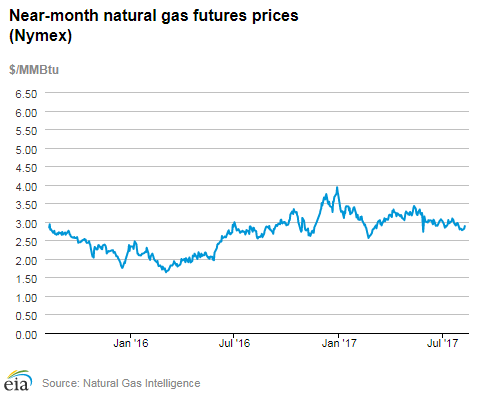
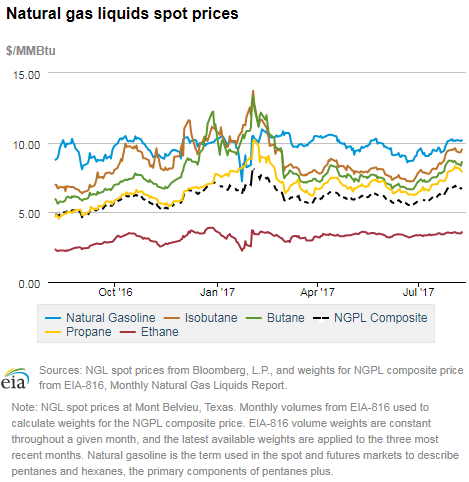
| U.S. natural gas supply - Gas Week: (8/3/17 - 8/9/17) | |||
|---|---|---|---|
Average daily values (Bcf/d): |
|||
this week |
last week |
last year |
|
| Marketed production | 82.5 |
82.0 |
80.0 |
| Dry production | 73.2 |
72.8 |
71.3 |
| Net Canada imports | 5.9 |
6.0 |
6.4 |
| LNG pipeline deliveries | 0.0 |
0.0 |
0.2 |
| Total supply | 79.1 |
78.8 |
78.0 |
|
Source: OPIS PointLogic Energy, an IHS Company | |||
| U.S. natural gas consumption - Gas Week: (8/3/17 - 8/9/17) | |||
|---|---|---|---|
Average daily values (Bcf/d): |
|||
this week |
last week |
last year |
|
| U.S. consumption | 59.6 |
60.1 |
62.3 |
| Power | 33.0 |
34.6 |
36.5 |
| Industrial | 19.8 |
19.7 |
19.3 |
| Residential/commercial | 6.8 |
5.9 |
6.4 |
| Mexico exports | 4.4 |
4.3 |
4.2 |
| Pipeline fuel use/losses | 6.4 |
6.5 |
6.7 |
| LNG pipeline receipts | 1.8 |
2.1 |
0.9 |
| Total demand | 72.3 |
72.9 |
74.1 |
|
Source: OPIS PointLogic Energy, an IHS Company | |||
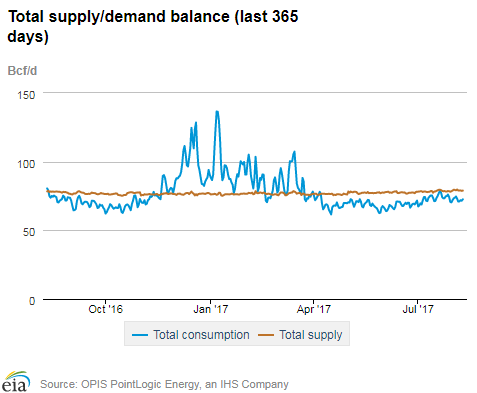
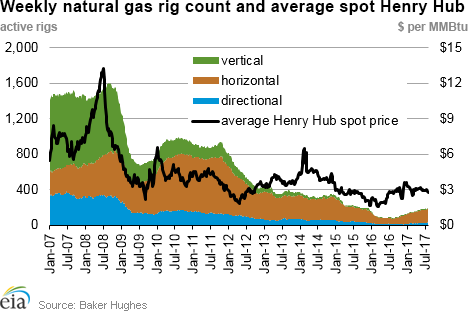
| Rigs | |||
|---|---|---|---|
Fri, August 04, 2017 |
Change from |
||
last week |
last year |
||
| Oil rigs | 765 |
-0.1% |
100.8% |
| Natural gas rigs | 189 |
-1.6% |
133.3% |
| Note: Excludes any miscellaneous rigs | |||
| Rig numbers by type | |||
|---|---|---|---|
Fri, August 04, 2017 |
Change from |
||
last week |
last year |
||
| Vertical | 73 |
2.8% |
25.9% |
| Horizontal | 807 |
-0.4% |
122.9% |
| Directional | 74 |
-3.9% |
68.2% |
| Source: Baker Hughes Inc. | |||
| Working gas in underground storage | ||||
|---|---|---|---|---|
Stocks billion cubic feet (Bcf) |
||||
| Region | 2017-08-04 |
2017-07-28 |
change |
|
| East | 673 |
651 |
22 |
|
| Midwest | 771 |
754 |
17 |
|
| Mountain | 202 |
200 |
2 |
|
| Pacific | 289 |
293 |
-4 |
|
| South Central | 1,103 |
1,112 |
-9 |
|
| Total | 3,038 |
3,010 |
28 |
|
| Source: U.S. Energy Information Administration | ||||
| Working gas in underground storage | |||||
|---|---|---|---|---|---|
Historical comparisons |
|||||
Year ago (8/4/16) |
5-year average (2012-2016) |
||||
| Region | Stocks (Bcf) |
% change |
Stocks (Bcf) |
% change |
|
| East | 744 |
-9.5 |
698 |
-3.6 |
|
| Midwest | 842 |
-8.4 |
750 |
2.8 |
|
| Mountain | 215 |
-6.0 |
178 |
13.5 |
|
| Pacific | 314 |
-8.0 |
331 |
-12.7 |
|
| South Central | 1,198 |
-7.9 |
1,020 |
8.1 |
|
| Total | 3,313 |
-8.3 |
2,977 |
2.0 |
|
| Source: U.S. Energy Information Administration | |||||
| Temperature – heating & cooling degree days (week ending Aug 03) | ||||||||
|---|---|---|---|---|---|---|---|---|
HDD deviation from: |
CDD deviation from: |
|||||||
| Region | HDD Current |
normal |
last year |
CDD Current |
normal |
last year |
||
| New England | 2 |
-1 |
1 |
38 |
-7 |
-24 |
||
| Middle Atlantic | 1 |
-2 |
1 |
54 |
-5 |
-20 |
||
| E N Central | 2 |
-2 |
2 |
47 |
-10 |
-21 |
||
| W N Central | 3 |
0 |
2 |
53 |
-18 |
-12 |
||
| South Atlantic | 0 |
0 |
0 |
85 |
-12 |
-37 |
||
| E S Central | 0 |
0 |
0 |
78 |
-17 |
-28 |
||
| W S Central | 0 |
0 |
0 |
121 |
-5 |
-13 |
||
| Mountain | 1 |
-2 |
1 |
86 |
8 |
-14 |
||
| Pacific | 0 |
-2 |
0 |
81 |
34 |
0 |
||
| United States | 1 |
-1 |
1 |
73 |
-1 |
-19 |
||
|
Note: HDD = heating degree day; CDD = cooling degree day Source: National Oceanic and Atmospheric Administration | ||||||||
Average temperature (°F)
7-Day Mean ending Aug 03, 2017
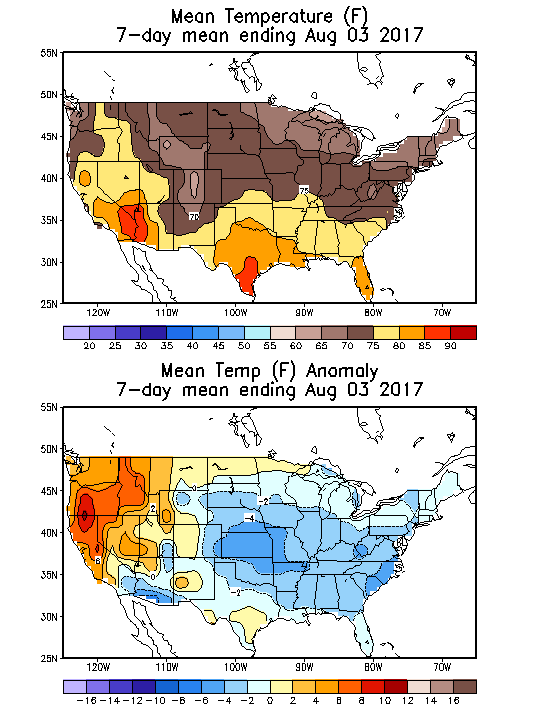
Source: NOAA National Weather Service
Deviation between average and normal (°F)
7-Day Mean ending Aug 03, 2017

Source: NOAA National Weather Service

